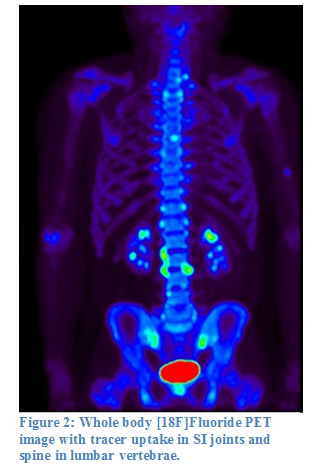Session Information
Session Type: ACR Poster Session B
Session Time: 9:00AM-11:00AM
Background/Purpose: Bone formation is an important hallmark of ankylosing spondylitis (AS). Recently, we demonstrated that axial bone formation activity in AS patients can be visualized in vivo by [18F]Fluoride PET-CT. [18F]Fluoride PET-CT may therefore allow monitoring of changes of bone formation in AS during treatment. Therefore we investigated 1. changes in bone formation activity in AS patients that start anti-TNF treatment using [18F]Fluoride-PET-CT and 2. Histology of PET identified lesions in spine (small feasibility sub-study).
Methods: We included 12 AS patients (female 7/12; age 39±11) with high disease activity (BASDAI 5.5±1.1). [18F]fluoride PET-CT scans were performed at baseline and 12 weeks of anti-TNF treatment. Two patients only obtained a baseline scan to identify PET+ lesions in spine for a subsequent biopsy procedure to collect material of these lesions for immunohistochemistry (IHC). PET scans were assessed visually by two blinded readers. Clinical response was defined according to the ASAS20 at 12 weeks.
Results: Visualization of bone formation by [18F]fluoride PET-CT in spine was supported by osteoid formation and osteoclasts along with cell infiltrate in conjunction areas of bone and connective tissue in PET+ lesions, while largely absent in PET- lesions (Figure 1A,B). At baseline, the other 10 patients showed at least one lesion of [18F]Fluoride uptake in spine and/or SI joints. In spine, a total of 94 PET+ lesions were observed in 6 patients (range 2-32 p.p.), and ≥1 SI PET+ joint in 8/10 patients (Fig. 2). After 12 weeks of anti-TNF treatment, 7/10 patients received ASAS20 response. In spine, in 6/10pts with ≥1 PET+ lesion at baseline, the number of PET+ lesions decreased from 94 to 66 in 12 weeks. Decrease of spine+ lesions was noticed both in clinical responders and non-responders although the remaining number of spine+ lesions at 12 weeks tended to be higher in non-responders than in responders (16-21 vs. 1-13, respectively). SI+ joints remained visually positive at 12 weeks although at variable intensity.
Conclusion: In AS patients, [18F]Fluoride PET-CT visualizes multiple lesions with bone formation in SI joints and spine. Histological evaluation of PET+ lesions supported in-vivo identification of bone formation activity by [18F]Fluoride PET-CT. In this preliminary visual analysis of PET data, one third of [18F]Fluoride PET-CT+ lesions in spine disappeared after 12 weeks of a-TNF treatment. The relationship between PET outcome and clinical response will be further investigated by quantitative analysis of PET+ lesions and clinical follow-up up to 24 weeks, which is currently in progress.
To cite this abstract in AMA style:
Bruijnen S, Verweij N, van Duivenvoorde L, Baeten D, van Denderen C, Bot J, Hoekstra O, Raijmakers P, van der Horst - Bruinsma I, van der Laken C. Imaging of Ankylosing Spondylitis By [18f]Fluoride PET-CT to Assess Bone Formation Activity and to Monitor Anti-TNF Therapy [abstract]. Arthritis Rheumatol. 2016; 68 (suppl 10). https://acrabstracts.org/abstract/imaging-of-ankylosing-spondylitis-by-18ffluoride-pet-ct-to-assess-bone-formation-activity-and-to-monitor-anti-tnf-therapy/. Accessed .« Back to 2016 ACR/ARHP Annual Meeting
ACR Meeting Abstracts - https://acrabstracts.org/abstract/imaging-of-ankylosing-spondylitis-by-18ffluoride-pet-ct-to-assess-bone-formation-activity-and-to-monitor-anti-tnf-therapy/


